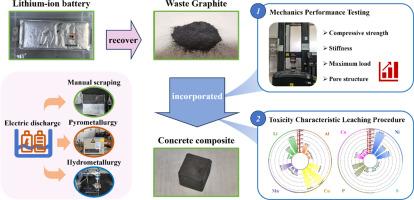Pollutant control and material conversion of the waste graphite recovered from spent lithium-ion batteries: Preparation of building composite materials
IF 10.9
1区 环境科学与生态学
Q1 ENGINEERING, ENVIRONMENTAL
引用次数: 0
Abstract
The development of sustainable methods for the recycling and disposal of spent lithium-ion batteries (LIBs) has become a research priority. A large amount of waste graphite containing metals, such as Ni, Co, and Cu, was produced in the recycling process of LIBs. It was classified as hazardous waste due to its high metal leaching concentration and requires safe disposal. In this study, the concentration leaching of Ni, Co, and Cu was inhibited to less than 2 mg/L in the toxicity characteristic leaching procedure through the preparation of concrete composite materials. It showed that 1% graphite incorporation can increase compressive strength by 7.75% and stiffness by 4.53% after 7 days of curing. Scenario and cost-effect analysis showed that under the optimistic scenario, the net income of 2400 yuan per ton can be achieved through the disposal subsidy and product income. This study provides a solution with both environmental and economic benefits for the safe disposal of waste graphite and promotes the collaborative development of LIBs recycling and green building materials.

废旧锂离子电池回收石墨的污染物控制与材料转化:建筑复合材料的制备
开发可持续回收和处理废旧锂离子电池的方法已成为研究重点。锂离子电池回收过程中产生了大量含Ni、Co、Cu等金属的废石墨。由于其金属浸出浓度高,被列为危险废物,需要安全处置。本研究通过制备混凝土复合材料,将毒性特征浸出过程中Ni、Co、Cu的浓度浸出抑制在2 mg/L以下。结果表明,掺量为1%的石墨固化7天后,抗压强度提高7.75%,刚度提高4.53%。情景和成本-效果分析表明,在乐观情景下,通过处置补贴和产品收益可以实现每吨2400元的净收入。本研究为废石墨的安全处理提供了一种既环保又经济的解决方案,促进了锂离子电池回收利用与绿色建材的协同发展。
本文章由计算机程序翻译,如有差异,请以英文原文为准。
求助全文
约1分钟内获得全文
求助全文
来源期刊

Resources Conservation and Recycling
环境科学-工程:环境
CiteScore
22.90
自引率
6.10%
发文量
625
审稿时长
23 days
期刊介绍:
The journal Resources, Conservation & Recycling welcomes contributions from research, which consider sustainable management and conservation of resources. The journal prioritizes understanding the transformation processes crucial for transitioning toward more sustainable production and consumption systems. It highlights technological, economic, institutional, and policy aspects related to specific resource management practices such as conservation, recycling, and resource substitution, as well as broader strategies like improving resource productivity and restructuring production and consumption patterns.
Contributions may address regional, national, or international scales and can range from individual resources or technologies to entire sectors or systems. Authors are encouraged to explore scientific and methodological issues alongside practical, environmental, and economic implications. However, manuscripts focusing solely on laboratory experiments without discussing their broader implications will not be considered for publication in the journal.
 求助内容:
求助内容: 应助结果提醒方式:
应助结果提醒方式:


